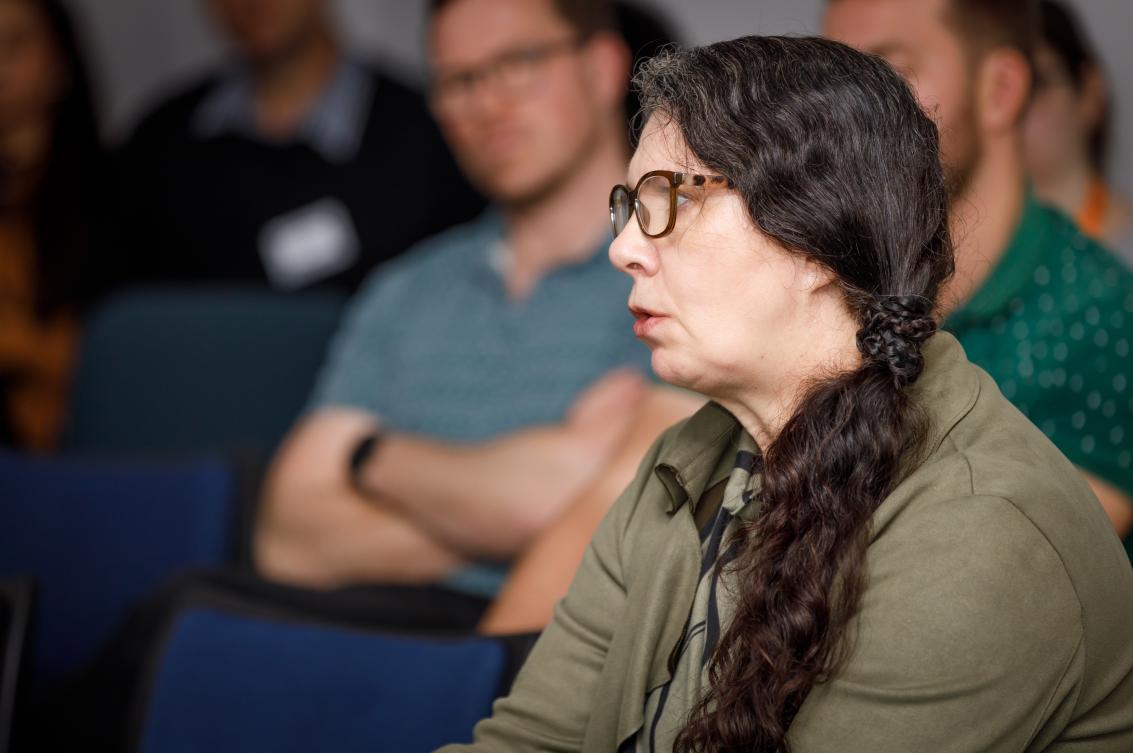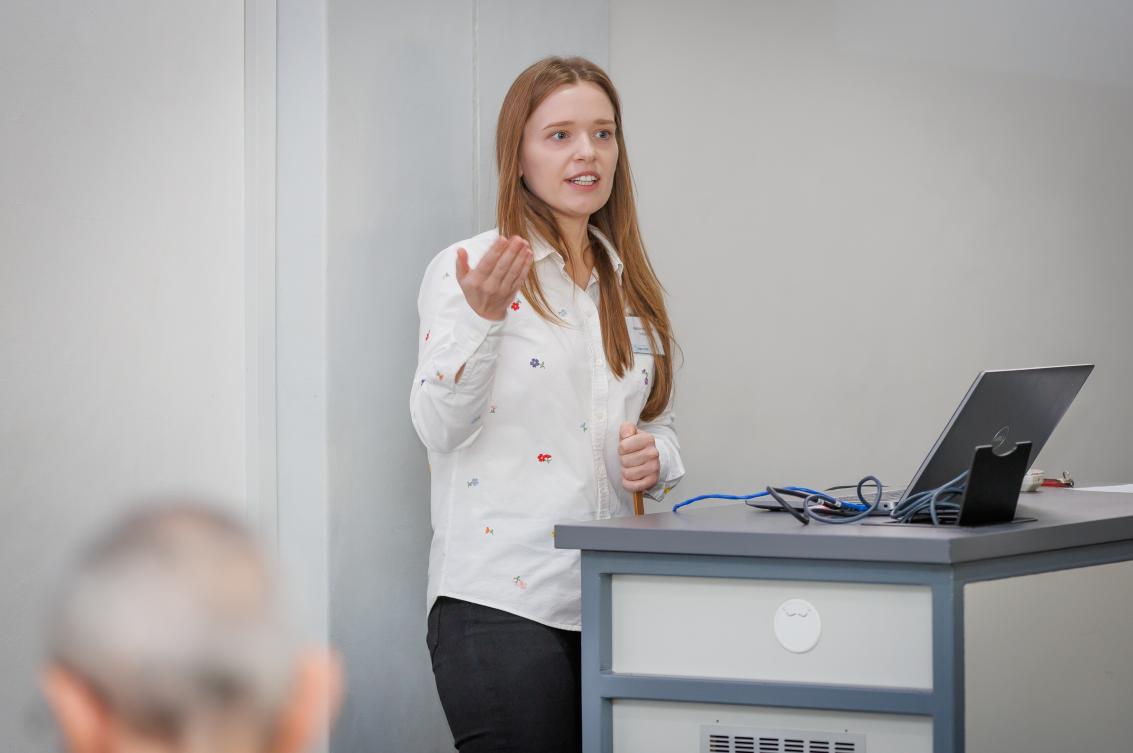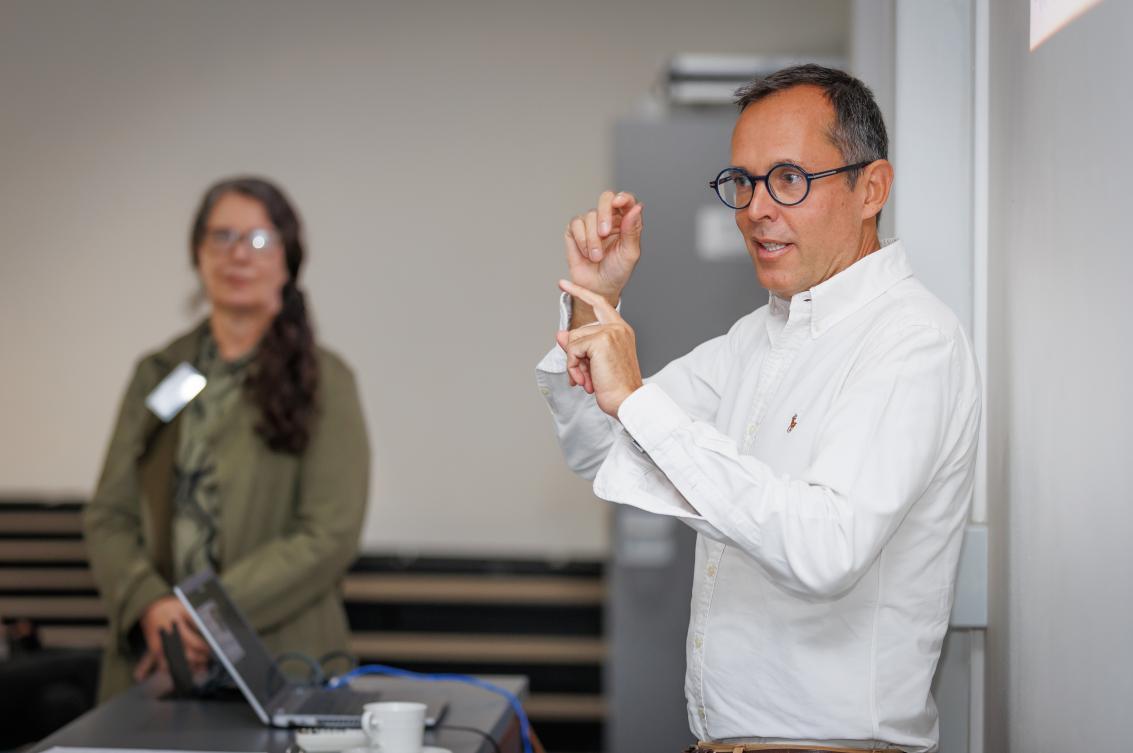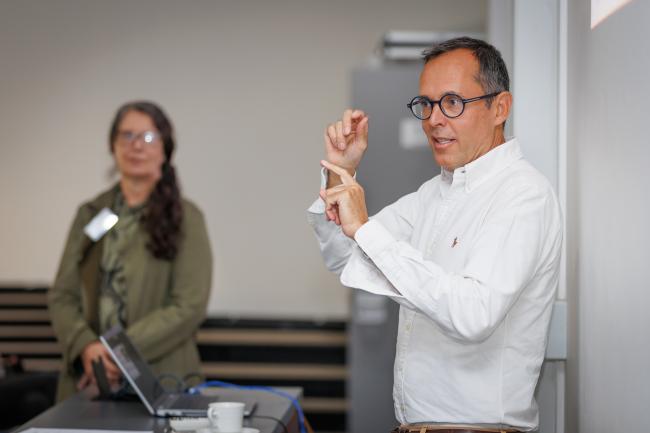
Prof Joao Cabral from the Department of Chemical Engineering at Imperial College London demonstrated how they are taking inspiration from nature to develop antimicrobial surfaces.
“Out-of-the-box” technologies needed to fight against multi-drug-resistant pathogens
- New approaches must be found in the fight against multi-drug-resistant pathogens.
- Workshop focuses on nanosolutions for antimicrobial surfaces in public spaces and hospital's Intensive Care Units.
Some of the latest “out-of-the-box” technologies and research in the fight against multi-drug-resistant pathogens in hospitals’ Intensive Care Units and public transport were discussed at a workshop at Stellenbosch University (SU) recently.
The workshop, titled “Nanosolutions for antimicrobial surfaces”, showcased the latest findings from research groups participating in a European Union-funded programme, Triple-A COAT. The objective of the Triple A COAT project is to develop a green nanocellulose coating with antibacterial, antifungal and antiviral functionalities to limit the transfer of pathogens in public places.
Nanocellulose materials are a type of superstrong, lightweight substance made from cellulose – the main building block of plant cell walls. Certain celluloses can self-assemble into nanoscale particles to form nanocellulose.
Prof Marina Rautenbach, head of the BIOPEP Peptide Group in SU’s Department of Biochemistry, says it is imperative that new approaches must be found in the fight against multidrug-resistant microbes – the big six being the so-called ESKAPE pathogens, namely Enterococcus faecium, Staphylococcus aureus, Klebsiella pneumoniae, Acinetobacter baumannii, Pseudomonas aeruginosa, and Enterobacter species.
“These pathogens are all highly virulent and resistant to most known antibiotics. As a result, they are the major cause of life-threatening hospital-acquired infections throughout the world,” she explains.
During the workshop, Dr Elanna Bester from SU’s Department of Microbiology presented the results of their research on the alarming correlation between pathogen surface transfer and patient infections.
In another presentation, Prof Joao Cabral from the Department of Chemical Engineering at Imperial College London demonstrated how they are taking inspiration from nature to develop antimicrobial surfaces: “We look at the nano- and microtopography of insect and plant surfaces and how they effectively augment their chances to fight off the bacteria and fungi that are trying to kill them.”
Dr Aleksandra Cerbrat from SuSoS AG in Switzerland explained progress in the development of a coating, based on nano-cellulose, that will adhere to different surfaces in a bus, while Dr Eugene Smith from the Stellenbosch Nanofibre Company, shared their progress made in the large-scale manufacturing of antimicrobial wound care products using nanofibres.
Learning from nature
At Stellenbosch, Prof Rautenbach’s research group focuses on the structure and mechanisms of action of the antimicrobial peptides produced by the soil bacterium Brevibacillus parabrevis. In nature, these organisms have evolved many strategies of defence against competing bacteria, fungi and parasites.
Over the past 80 years, the peptides produced by B. parabrevis have been used as a topical antibiotic without documented resistance. Recently Rautenbach’s group discovered that small natural cyclodecapeptides (CDPs) in the antimicrobial peptides stick tightly to each other and most materials, such as wood, paper, cotton, and plastics.
“These cyclodecapeptides form small sticky-like nanoballs and it seems that these nanoballs are the active units killing off any bacteria, fungi or viruses in its vicinity. In other words, they naturally form nanostructures in the fibres of cellulose materials, thereby functioning with self-sterilising activity,” she explains.
In a collaboration with scientists from the Microbial Communities and Antimicrobials (MICA) research group at KU Leuven, they found these peptides to be effective against most ESKAPE pathogens, including Escherichia coli and the fungal pathogen Candida albicans.
At KU Leuven Dina El Jaramany, a PhD student working on the project, found that another group of compounds, the 2 amino-imidazoles (2-Ais), also have a broad spectrum of activity against ESKAPE pathogens in nanocellulose. Recently, Simon Berge, a researcher in the BIOPEP group at SU, demonstrated that the 2-AIs and CDPs have synergistic surface antimicrobial activity when combined in nanocelluloses.
According to the Triple-A-Coat website, their approach is to work with nature-inspired approaches with minimal risk of resistance development, while avoiding the safety issues associated with nanoparticles. In the final stage of the project, the best performing coatings will be tested in a public bus simulation booth constructed at KU Leuven. This four-year project is planned to come to an end in August 2026.
- You can follow the news on Triple-A-Coat on X (https://twitter.com/i/flow/login?redirect_after_login=%2FTriple_A_COAT), LinkedIn (https://www.linkedin.com/showcase/triple-a-coat) and Facebook (https://m.facebook.com/100088378923945/).
- Triple-A-COAT is funded by the European Union. Views and opinions expressed are however those of the author(s) only and do not necessarily reflect those of the European Union or The European Health and Digital Executive Agency. Neither the European Union nor the granting authority can be held responsible for them.




















